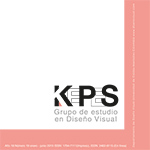Authors
Abstract
This paper is derived from the Macro Project of the Xisqua Research Group: Notions of Territory: City, Maps and imaginart. The study presented reflects on the virtual dimensions of the city as an opportunity for analysis of urban relations that are developing in the use of mobile applications and the understanding of the appropriation of the territory.
In this case the users of the Pokémon Go application were taken as the object of study, in which the opportunity to analyze the spatial relationships between reality and virtuality in the urban context is detected.
The development of the project is proposed as a pilot approach in which an exercise of inquiry was carried out using techniques such as participant observation and instruments such as application of surveys to the users of the game. This approach to the subject suposses the possibility of establishing a new perspective for the approach to the territory and to the notions that are developing between the interaction to the citizen and the urban environment, in this case from virtual scenarios.
Keywords
References
Basogain, X. et al. (2010). Realidad aumentada en la educación: una tecnología emergente. Recuperado de http://files.mediaticos.webnode.es/200000016-a645ea73b3/realidad%20A..pdf.
Borja, J. y Castells, M. (2000). Local y global. La gestión de las ciudades en la era de la información. Ciudad de México, México: Taurus.
Dawley, L. and Dede, C. (2014). Situated learning in virtual worlds and inmersive simulations. En J.M. Spector et al. (Eds.), The Handbook of Research for Educational Communications and
Technology. New York, USA: Springer.
Ibarrola, D. (2017). ¡Atrápalos ya! Prácticas y relaciones sociales en torno a Pokémon Go. Lúdicamente, 6 (11).
Lynch, K. (1984). La imagen de ciudad. Barcelona, España: Gustavo Gilli.
Morales, J. (2014). Innovación en el diseño de los mundos ficticios en los videojuegos educativos. Un cambio hacia entornos más abiertos a la participación significativa y el aprendizaje. Revista KEPES, 11 (10), 167-193.
Negroponte, N. (1995). Ser digital. Buenos Aires, Argentina: Editorial Atlántida.
Rodríguez, C.M. (2014). Imaginarios y cartografías urbanas: la ciudad de Tunja como caso de estudio. IconoFacto, 10, (14), 35-50.
Scolari, C. (2013). Narrativas transmedia. Cuando todos los medios cuentan. Barcelona, España: Deusto.
Silva, A. (07 de agosto de 2016). Ciudad de aire. El Tiempo.
UNESCO. (2017). Las piedras angulares para la promoción de sociedades del conocimiento inclusivas. Paris, Francia: UNESCO.
Vila, E. y Vilar, M. (2016). Perseguimos quimeras con un celular. Un examen del ficcional del Pokemon Go. Revista Luthor, 7 (29).

 pdf (Español (España))
pdf (Español (España))
 FLIP
FLIP






















